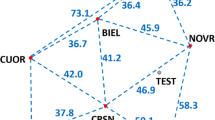Abstract
Russian global navigation satellite system (GLONASS) provides civilian and military users three-dimensional position determination and navigation services as same as US global positioning system. Geometric dilution of precision (GDOP) provides a simple interpretation of positioning precision. Usual method for GLONASS GDOP calculation is matrix inversion. However this process imposes a huge calculation load on receiver, especially when large number of visible satellites exists. To overcome this problem, artificial neural network is used. Different configurations and training methods are simulated on a data base obtained by a GLONASS receiver. Then navigation precision and execution times are explored and compared. Results show that recurrent neural network has 0.00024 RMS error, which is the best against other focused tools including feed forward back propagation and radial basis function neural network with usual training and with genetic algorithm adopted weights and biases.





Similar content being viewed by others
References
GLONASS Interface Control Document Navigational Radio Signal in Bands L1, L2. Edition 5.1, Russia, 2008.
Walter, T., Blanch, J., Choi, M. J., Reid, T., & Enge, P. (2013). Incorporating GLONASS into aviation RAIM receivers. In Proceedings of the international technical meeting of the institute of navigation.
Constantinescu, A., & Landry, R. J. (2005). GPS/Galileo/GLONASS hybrid satellite constellation simulator-GPS constellation validation analysis. In 61st annual meeting of the institute of navigation (pp. 733–737).
Melgard, T., Vigen, E., & Orpen, O. (2009) Advantages of combined GPS and GLONASS PPP—experiences based on G2. A new service from Fugro. In 13th IAIN World Congress, Stockholm.
Blanch, J., Walter, T., & Enge, P. (2012). Satellite navigation for aviation in 2025. In Proceedings of the IEEE special centennial issue (Vol. 100, pp. 1821–1830).
Yarlagadda, R., Ali, I., Al-Dhahir, N., & Hershey, J. (2000). GPS GDOP metric. IEEE Proceedings on Radar, Sonar and Navigation, 147, 259–264.
Azami, H., Mosavi, M. R., & Sanei, S. (2013). Classification of GPS satellites using improved back propagation training algorithms. Journal of Wireless Personal Communications, 71(2), 789–803.
Simon, D., & El-Sherief, H. (2005). Navigation satellite selection using neural networks. Journal of Neurocomputing, 7, 247–258.
Jwo, D. J., & Chin, K. P. (2002). Applying back-propagation neural networks to GDOP approximation. Journal of Navigation, 55(1), 97–108.
Tafazoli, S., & Mosavi, M. R. (2011). Performance improvement of GPS GDOP approximation using recurrent wavelet neural network. Journal of Geographic Information System, 3(4), 318–322.
Ch, W., Su, W., & Yw, H. (2011). A study on GPS GDOP approximation using support-vector machines. IEEE Transactions on Instrumentation and Measurement, 60(1), 137–145.
Kovach, K. (200). New user equivalent range error (UERE) budget for the modernized navstar global positioning system (GPS). In Proceedings of the 2000 national technical meeting of the institute of navigation (pp. 550–573).
Jwo, D. J., & Lai, C. C. (2007). Neural network-based GPS GDOP approximation and classification. Journal of GPS Solutions, 11(1), 51–60.
Saraf, M., Mohammadi, K., & Mosavi, M. R. (2011). Bayesian framework on GPS GDOP classification. Journal of Computers and Electrical Engineering, 37, 1009–1018.
Mosavi, M. R., & Azami, H. (2011). Applying neural network for clustering of GPS satellites. Journal of Geoinformatics, 7(3), 7–14.
Karry, F. O., & De Silva, C. (2004). Soft computing and intelligent systems design: theory, tools and applications. Pearson: Addison-Wesley.
Mosavi, M. R. (2007). GPS receivers timing data processing using neural networks: Optimal estimation and errors modeling. Journal of Neural Systems, 17(5), 383–393.
Mosavi, M. R. (2011). Wavelet neural network for corrections prediction in single-frequency GPS users. Neural Processing Letters, 33(2), 137–150.
Tabatabaei, A., Mosavi, M. R., & Farajiparvar, P. (2012). A traveling-wave fault location technique for three-terminal lines based on wavelet analysis and recurrent neural network using GPS timing. In Conference on smart electrical grids technology (SEGT2012) (pp. 154–158, 18–19).
Mosavi, M. R. (2010). Estimation of pseudo-range DGPS corrections using neural networks trained by evolutionary algorithms. Journal of Review of Electrical Engineering, 5(6), 2715–2721.
Author information
Authors and Affiliations
Corresponding author
Rights and permissions
About this article
Cite this article
Tabatabaei, A., Mosavi, M.R. Rapid and Precise GLONASS GDOP Approximation using Neural Networks. Wireless Pers Commun 77, 2675–2685 (2014). https://doi.org/10.1007/s11277-014-1660-z
Published:
Issue Date:
DOI: https://doi.org/10.1007/s11277-014-1660-z




